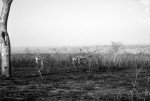Text and photos -- James R. Gosz, Chair, ILTER Network
The ILTER meeting in South Africa also allowed participants to view some of the important research efforts in Kruger National Park as well as to view the important fauna and flora of the Park.
One of the most impressive studies is a burning experiment that was initiated in 1954 and has continued unaltered to the present. The experiment was laid out as a randomized block design with four replicates comprising different seasons and frequencies of burning. 208 plots are involved (7 ha each) in the combination of burning frequency (no burn,1, 2, 3 4, 6 yrs) and season of burn (spring, early summer, mid-summer, autumn, mid-winter). This experiment is performed on 4 different regions of the National Park that differ in geology, soils and vegetation.
Results also differ markedly in the different regions of the Park. In some areas there is relatively little difference among the treatments while in others the density of woody plants and herbaceous species diversity varies significantly. Use of the plots by large herbivores also varies with different treatments and on different areas.
These experiments provide an excellent opportunity for other scientists to evaluate other components of these ecosystems. There is an interest in the Park for studies on small mammals, birds, invertebrates, nutrient dynamics and soils. These long-term experiments have created interesting and valuable changes to the ecosystems of this region that have relevance to many of our current issues of global change and management.
South Africa -- Opportunities for Long Term Research
By:
James R. Gosz 
 Enlarge this image
Enlarge this image



